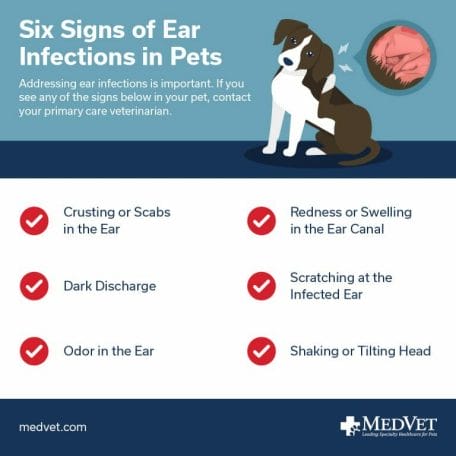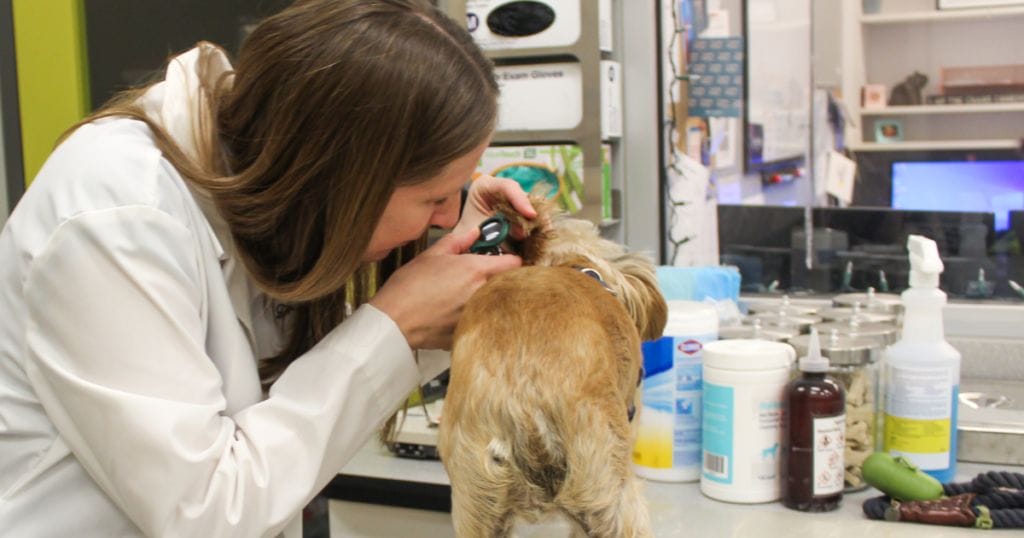
Ear infections in pets can be painful and uncomfortable, just like they are in humans. If ear infections are recurrent or persistent, they are usually secondary to a primary condition that initiates the inflammation and fuels the overgrowth of yeast or bacteria. Potential causes include primary allergic diseases, a foreign body, a polyp or mass, endocrinopathies, and auto-immune skin diseases.
Grooming practices (plucking too much hair, use of cotton swabs in the ear canal), swimming, and your pet’s breed can make some pets more likely to develop ear infections. Over time, chronic changes to the ear canal tissue, development of bacterial biofilm, drug-resistent isolates, and middle ear infections may occur and complicate effective treatment.
Signs of an Ear Infection
You will notice one of more of the following signs if your dog or cat has an ear infection:
- Scratching at the affected ear or at the face
- Head shaking, ear rubbing, or tilting of the head
- Redness or swelling in the ear canal or pinnae
- Crusting or scabs
- Abundant ear wax
- Purulent discharge or pus of any color
- Odor
- Dark brown wax or a slimy discharge
If you notice any of these signs in your pet, it is best to take them to your family veterinarian for proper diagnosis and treatment.

What Causes an Ear Infection?
Inflammation and subsequent overgrowth of yeast and/or bacteria cause ear infections. Allergic otitis may not have any infection, just inflammation.
There are three types of ear infections: external canal (Otitis externa, OE), middle ear (Otitis media, OM), and the inner ear or brain (Otitis interna, OI). In this post, we are mostly discussing OE and OM, which account for most ear infections.
Diagnosing External Ear Infections (OE)
Your pet’s care team will obtain a complete history by asking you questions like the signs your pet is displaying and for how long, which ears are affected, if they are experiencing neurologic side effects, and more.
Your veterinarian will use an otoscope to look down each ear canal to the ear drum (tympanic membrane) to examine the ear canal, look for foreign material, and examine the ear drum. They may also recommend diagnostic tests to look for yeast, bacteria, parasites, or other issues. Your veterinarian may recommend imaging studies if the middle or inner ear cavities are potentially affected.
If your pet is in too much pain or the ear canal is too swollen, a thorough evaluation may not be possible at the initial visit. Your veterinarian may send your pet home for a few days with an oral steroid to decrease the inflammation and open the ear canal. They may also prescribe pain medications to make your pet more comfortable.

Treating External Ear Infections (OE)
Your pet may only need an ear cleaner to remove debris, organisms, or address inflammation if they have an external infection. Some pets may need a topical steroid for at-home use in addition to the ear cleaner. Oral steroids are rarely used for external ear canal infections unless certain bacteria are present or there is an ulcerated ear canal or topical reaction. Treatment varies from seven to 30 days depending on the severity of the infection.
Diagnosing and Treating Middle Ear Infections (OM)
If your pet has chronic ear infections or neurologic signs, your family veterinarian may refer you to a veterinary dermatologist for further evaluation.
To diagnose OM, your pet will undergo anesthesia for imaging such as a CT (Computerized Tomographic), MRI (Magnetic Resonance Imaging), video-otoscopy (VO), which is an ear camera, or a myringotomy.
For the myringotomy procedure, a puncture in the middle ear is done by catheter or needle to sample the fluid for culture and to flush any liquids/debris until it is clear. The dermatologist will culture the sample taken from the ear to learn what was growing in the ear canal, ensuring a prescription for a medication specific to your pet’s needs. Following the myringotomy, your pet will be on an oral and systemic topical medication for one to three months. Regular check-ups with your veterinary dermatologist will evaluate how the ear drum is healing and how your pet is responding to treatment.
If your pet has a mass, advanced imaging such as the VO machine will allow your veterinary dermatologist to get better images of the mass and help biopsy or remove the mass with special tools or a laser.
How You Can Prevent Ear Infections in Pets
Keeping your pet’s ears clean with a veterinary-approved cleaner is the best way to help remove any debris or dirt that could potentially lead to an infection. Additionally, it is important to keep your pet away from damp areas, which can increase the risk of an ear infection.
Finally, take your pet to your family veterinarian for regular checkups to ensure that their ears are healthy and free of infection. If your pet needs specialty care for their ear infections, we are always here for you at MedVet. You may also ask for a referral to a veterinary dermatologist or your nearest MedVet.